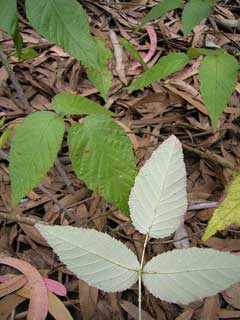 |
|
http://www.hear.org/starr/ |
 |
| http://www.hear.org/starr/ |
Translate this page:
Summary
Physical Characteristics

 Rubus glaucus is a deciduous Shrub growing to 3 m (9ft 10in).
Rubus glaucus is a deciduous Shrub growing to 3 m (9ft 10in).
See above for USDA hardiness. It is hardy to UK zone 9. The species is hermaphrodite (has both male and female organs) and is pollinated by Apomictic (reproduce by seeds formed without sexual fusion). The plant is self-fertile.
Suitable for: light (sandy), medium (loamy) and heavy (clay) soils and prefers well-drained soil. Suitable pH: mildly acid, neutral and basic (mildly alkaline) soils. It can grow in semi-shade (light woodland) or no shade. It prefers moist soil.
UK Hardiness Map
US Hardiness Map
Synonyms
Plant Habitats
Woodland Garden Sunny Edge;
Edible Uses
Edible Parts: Fruit
Edible Uses:
Fruit - raw or cooked[196]. Rich, tart and very juicy, they are superior in flavour and quality to most cultivated blackberries and raspberries[196]. Similar to a loganberry in terms of taste and utility. The fruit is up to 3cm long[196].
References More on Edible Uses
Medicinal Uses
Plants For A Future can not take any responsibility for any adverse effects from the use of plants. Always seek advice from a professional before using a plant medicinally.
None known
References More on Medicinal Uses
The Bookshop: Edible Plant Books
Our Latest books on Perennial Plants For Food Forests and Permaculture Gardens in paperback or digital formats.

Edible Tropical Plants
Food Forest Plants for Hotter Conditions: 250+ Plants For Tropical Food Forests & Permaculture Gardens.
More

Edible Temperate Plants
Plants for Your Food Forest: 500 Plants for Temperate Food Forests & Permaculture Gardens.
More

More Books
PFAF have eight books available in paperback and digital formats. Browse the shop for more information.
Shop Now
Other Uses
Dye Dye
Because the plant has a resistance to cane-spot disease (Mycosphaerella rubi) and also has potential for improving the quality of other fruits, this species is crossed with Rubus cultivars in breeding programmes[317
].
This species could be useful in hybridization programmes with American and European blackberries and raspberries, but it is susceptible to some N. American raspberry diseases[196
].
A purple to dull blue dye is obtained from the fruit[168
].
Special Uses
Food Forest
References More on Other Uses
Cultivation details
Easily grown in a good well-drained loamy soil in sun or semi-shade[1, 11, 200]. This species is not hardy in the colder areas of the country, it tolerates temperatures down to between -5 and -10°c[200]. Often cultivated in S. America for its edible fruit[196]. Yields of up to 20 tonnes per hectare are achieved in S. America[196]. This species could be useful in hybridization programmes with American and European blackberries and raspberries, but it is susceptible to some N. American raspberry diseases[196]. Closely related to R. occidentalis[200]. Plants in this genus are notably susceptible to honey fungus[200].
References Carbon Farming Information and Carbon Sequestration Information
Temperature Converter
Type a value in the Celsius field to convert the value to Fahrenheit:
Fahrenheit:
The PFAF Bookshop
Plants For A Future have a number of books available in paperback and digital form. Book titles include Edible Plants, Edible Perennials, Edible Trees,Edible Shrubs, Woodland Gardening, and Temperate Food Forest Plants. Our new book is Food Forest Plants For Hotter Conditions (Tropical and Sub-Tropical).
Shop Now
Plant Propagation
Seed - requires stratification and is best sown in early autumn in a cold frame. Stored seed requires one month stratification at about 3°c and is best sown as early as possible in the year. Prick out the seedlings when they are large enough to handle and grow on in a cold frame. Plant them out into their permanent positions in late spring of the following year. Cuttings of half-ripe wood, July/August in a frame[200]. Tip layering in July. Plant out in autumn. Division in early spring or just before leaf-fall in the autumn[200].
Other Names
If available other names are mentioned here
Mora de Castilla, Andes-berry, Mora, Andes black raspberry,
Native Range
SOUTHERN AMERICA: Costa Rica, Guatemala, Panama, Colombia, Ecuador, Peru, Huánuco,
Weed Potential
Right plant wrong place. We are currently updating this section.
Please note that a plant may be invasive in one area but may not in your area so it's worth checking.
Conservation Status
IUCN Red List of Threatened Plants Status : This taxon has not yet been assessed

Growth: S = slow M = medium F = fast. Soil: L = light (sandy) M = medium H = heavy (clay). pH: A = acid N = neutral B = basic (alkaline). Shade: F = full shade S = semi-shade N = no shade. Moisture: D = dry M = Moist We = wet Wa = water.
Now available:
Food Forest Plants for Mediterranean Conditions
350+ Perennial Plants For Mediterranean and Drier Food Forests and Permaculture Gardens.
[Paperback and eBook]
This is the third in Plants For A Future's series of plant guides for food forests tailored to
specific climate zones. Following volumes on temperate and tropical ecosystems, this book focuses
on species suited to Mediterranean conditions—regions with hot, dry summers and cool, wet winters,
often facing the added challenge of climate change.
Read More
Expert comment
Author
Benth.
Botanical References
200
Links / References
For a list of references used on this page please go here
A special thanks to Ken Fern for some of the information used on this page.
Readers comment
© 2010, Plants For A Future. Plants For A Future is a charitable company limited by guarantee, registered in England and Wales. Charity No. 1057719, Company No. 3204567.